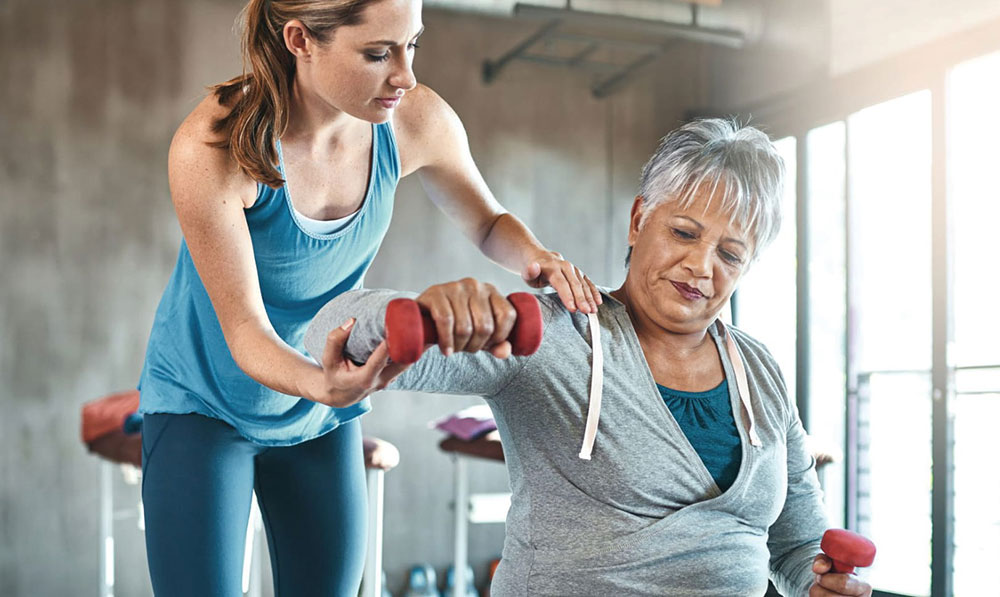Safe Exercising for Seniors
It is recommended that adults aged 65 and older get at least two and half hours of moderate exercise each week, or around 30 minutes every day. Consistent exercise can help improve and maintain mental and physical health and general well-being. It can also alleviate or correct some chronic health problems.
Even seniors with limited mobility can incorporate daily exercise into their routines. However, it’s important to talk to your doctor before beginning any new workouts or training programs, especially if you are new to exercising. When you’re ready to begin, here are some safe exercise options for seniors of all physical ability levels.
Why exercise is important for seniors
While exercise is key to a good quality life for individuals of any age, it is especially important for older adults. Moderate aerobic exercise can help older adults improve and maintain their:
- Strength and muscle mass
- Balance and coordination
- Cognitive abilities
- Mood and mental health
- Independence and self-reliance
By making exercising a habit, seniors can live longer, healthier, happier lives. But it’s important to exercise safely and avoid straining your body past its limits, especially if you have chronic health problems or physical limitations.
Exercises for seniors with full mobility
If you have low or no physical limitations, there is a wide variety of exercises you can do. But the easiest way to stick with a workout routine is to find one that you genuinely enjoy and look forward to.
Many seniors, even if they are in good health, need low-impact exercises that put less stress on their joints. So here are some great workout options that can help improve joint function, rather than hurting it.
Yoga — Yoga is a good choice for improving strength, balance, and flexibility. You can use beginner level DVDs or online videos to start practicing at home, or you can attend classes at a local gym or yoga studio.
Pilates — Pilates offers many of the same benefits as yoga, but with a greater emphasis on building strength and muscle mass. While you can do some pilates training at home, a gym or pilates studio will offer more of the specialized equipment used in the practice.
Swimming — Swimming is a fantastic low-impact form of exercise that works every part of the body. If you don’t have access to a private pool that you can use, many gyms and recreation centers have lap pools for exercise.
Water aerobics — Water aerobics classes are extremely popular, as this type of workout is ideal for individuals with weak or painful joints. The buoyancy of the water eases joint stress, while the natural resistance helps build strength.
Walking — Simply and classic, walking is a fun, relaxing way to get into an exercise routine. You can stroll through your neighborhood, walk around your local mall, or take a nature walk through the woods.
Resistance band training — A cheap, basic set of resistance bands can provide you with a full workout that addresses every part of your body. You can easily do resistance band training at home, either with a list of exercises or by following along with a video.
Exercises for seniors with limited mobility
If you have limited mobility or more severe physical limitations, there are still plenty of exercises that you can do to improve your health and well-being. These exercise routines are great for seniors who have difficulty standing or walking.
Chair yoga — Like regular yoga, chair yoga helps improve strength and flexibility. However, it can be done completely from a seated position, making it an excellent option for immobile individuals.
Range of motion — This type of exercise consists mainly of gentle stretching to improve joint function and range of motion and reduce stiffness. To do this kind of exercise, you’ll need the help of a caregiver who can gently and safely ease you into the stretches.
Pedal exercises — With this workout, you’ll use a small machine called a pedal exerciser to improve arm and leg strength. It’s simple to do, only requires one compact piece of equipment, and it is designed to be performed from a bed or chair.
Resistance band training — Resistance band training made it on both lists, because it is fully adaptable to the abilities of the participant. If you have difficulty standing or walking, you can use resistance bands from a sitting or even reclining position.
Exercising safely
While exercise is vital to whole body health, it’s equally important to make sure that you are exercising safely. Pushing yourself to do a little more is great, but remember to avoid pushing yourself beyond your limits. A bit of soreness after a workout is normal, but an acute, intense pain is not.
So if you experience significant pain during or after a workout, make sure you visit your doctor to get it checked out as soon as possible and avoid any more exercise until your doctor clears you for it. If you have any severe problems, such as chest pain, difficulty breathing, or extreme dizziness, alert your caregiver or call 911 right away.
A great way to stay committed to an exercise program is to have a workout partner or accountability person. Have a friend, family member, or caregiver remind you to get your exercise in regularly or even workout with you. An in-home caregiver can help you exercise safely and consistently, especially if you have mobility issues. If you’re interested in in-home care, feel free to reach out to us for more information, contact us.

We are Superheroes in Comfortable Clothes™
We take care of our clients, their families, our staff, and our league of franchise owners.

